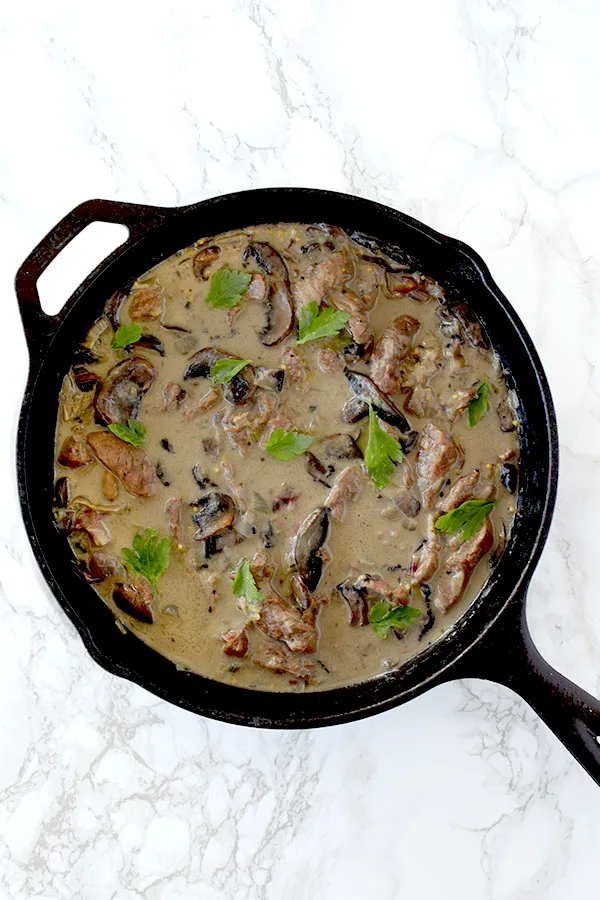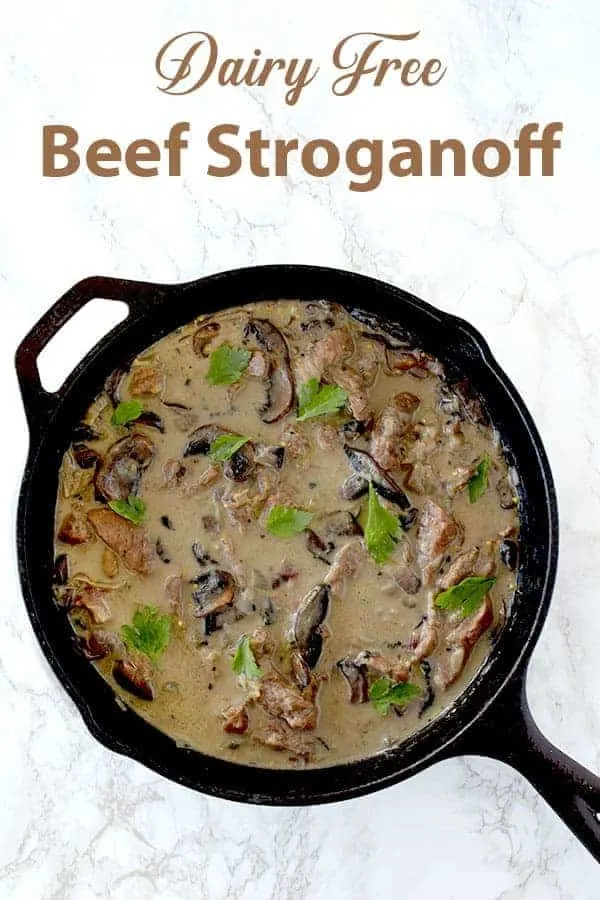Dairy free beef stroganoff is made without sour cream, but is just as rich and creamy as the classic, thanks to coconut cream. Aside from the coconut cream, this recipe is completely authentic.
Serve over mashed potatoes with a dill pickle on the side, as Russians do or over pasta.

Beef stroganoff was in part what inspired The Taste of Kosher.
I'd heard of the dish but never tasted it before and decided to look it up. I quickly realized that it had sour cream, making it not kosher, due to the restriction of cooking meat and milk together.
Then, I noticed that Worcestershire sauce (being English) was a popular ingredient and a big clue the recipes were inauthentic.
Now, not every recipe has to be authentic - tasty is tasty - but it being a cultural cuisine was a big draw for me.
So, I was frustrated by not being able to find authentic cultural recipes made kosher. While complaining to my mother about this, she suggested I make my own site and post such recipes.
I loved the idea and had one of my friends translate a number of beef stroganoff recipes so I could make it. I never like to follow just one recipe, so I usually work from a few and combine them.
Still, it took me quite a while before I got around to making it.
Russian Beef Stroganoff
While looking at the recipes, I was surprised to learn that Russian beef stroganoff was different in many ways than I had seen in photos.
It was often red due to the addition of tomato paste, it never had an option for ground beef, and it was served over mashed potatoes and with a dill pickle on the side.
Looking at the recipe, I also saw that it never included Worcestershire sauce. This was less of a surprise to me though, since Worcestershire sauce is English, whereas beef stroganoff is Russian.
How to eat beef stroganoff
Internationally, beef stroganoff is served over a plate of thick flat egg noodles. However, that is not actually the proper way to eat it.
In Russia, it is served over potatoes or rice if you're in a pinch. It is also always served with a pickle on the side, like all Russian meat dishes.
I discovered that the addition of the pickle is because in Russia, hot meat dishes are served with a pickle on the side. This solved the mystery of why a Russian friend was so often offering my pickles when we had dinner.
Following the meal, if you want to serve dessert, Russian Rogaliki with tea are just the thing!
Does beef stroganoff contain dairy?
Yes, beef stroganoff contains dairy since it is made with sour cream.
What can I use instead of sour cream in beef stroganoff?
To make this authentic Russian recipe dairy free, I decided to use coconut cream instead of sour cream.
At first, I was a little worried that it would taste like coconut or not taste right by not having any tang.
As it turns out though, Russian sour cream is not very sour. So, the loss of sourness wasn't much of an issue.
As for the coconut flavor given by the coconut cream, it didn’t change the flavor.
However, you should make sure to use a coconut cream that doesn't have a very strong coconut flavor. Some brands have a more distinct flavor than others.
Also, the lemon juice called for in this recipe helps neutralize the coconut flavor.
What is a good substitute for sour cream in beef stroganoff?
I personally like to use coconut cream with lemon juice in beef stroganoff instead of sour cream.
However, vegan sour creams should also work.
Even mayonnaise can work in a pinch.
What can I substitute for milk in beef stroganoff?
Beef stroganoff usually calls for sour cream, but in recipes that call for milk, simply replace the milk with a neutral flavored oat milk.
More stock will also do and water will work in a pinch.
STOCK VS. BROTH
Broth is usually thinner and made from meat, while stock is made from simmering bones for a long time.
Stock is usually thicker and has a richer mouth feel from the gelatin releases from the long-simmered bones.
Adding onions, carrots, celery, bay leaves, and other herbs add to the flavor of the stock.
WHAT ABOUT STORE-BOUGHT STOCKS AND BROTHS?
Commercial brands tend to use the terms “stock” and “broth” interchangeably, and store-bought stocks and broths are usually more broth than stock.
They tend to be lightly flavored, lack the body of a homemade stock, and result in a less flavorful dish.
HOW STOCKS AND BROTHS ARE MADE
Broths and stocks are also made differently.
Stocks are typically made from meaty raw bones, leftover carcasses, and meat and vegetable scraps. In the case of vegetable stock, only vegetables are used.
Stocks are simmered for several hours (unless you make pressure cooker stocks) to extract as much of the flavor from the ingredients as possible. This also extracts collagen from the bones and cartilage, which adds body and silkiness to the stock.
Broths are usually much lighter and have less body than stocks.
They’re most often made from poaching meat, vegetables, and seasonings in water for as long as it takes for the meat to cook or the broth to pick up some flavor.
HOW STOCKS AND BROTHS ARE USED
In classic French cuisine, stocks are considered to be an ingredient that’s used to make other things.
Also, they’re typically left unseasoned or only minimally seasoned so that they can be used in as wide a variety of ways as possible.
Stocks can be used to make soup, be reduced into a sauce or a glaze, or as an ingredient in many recipes.
Broths, on the other hand, are salted, which restricts the ways they can be used.
For the most part, broths are consumed on their own or used as a base for soups, such as chicken soup.
These definitions of stocks as an ingredient and broths as a food product is the way classically trained chefs tend to think about such things in their restaurant kitchens.
IS KOSHER Meat BETTER?
Kosher animals are kept in better conditions than non-kosher animals due to strict kosher health requirements of the animals.
Also, the salting process used as part of the process of making meat kosher is similar to dry brining, and therefore produces a better quality meat.
While I’ve only eaten kosher meat and so I cannot compare, I’ve been told by non-Jews who do not keep kosher that they’ve noticed that kosher meat is of superior quality to cook with.
SHOULD YOU WASH Meat?
According to the USDA, you should not wash meat or poultry because water can splash bacteria up to 3 feet surrounding your sink.
A study done by Drexel University shows that it is best to move meat and poultry directly from package to pan. The heat from cooking will get rid any bacteria that may be present.
HOW CAN I CLEAN MY meat WITHOUT WASHING IT?
If you want to clean your meat without washing it, wipe it down with a wet paper towel.
Just make sure the paper towel doesn't touch anything else and to toss the paper towel right away.
HOW TO DEFROST Meat
IN THE FRIDGE
Defrosting meat in the fridge is the most highly recommended.
To do this, place the frozen meat in a pan and let it thaw. Oftentimes when meat thaws, it releases liquids that can leak onto your fridge, so the pan is really helpful.
Meat typically takes a full day to thaw. Once thawed, it can remain in the refrigerator for a day or two before cooking.
IN COLD WATER
Defrosting meat in water should take two to three hours.
Submerge your sealed meat in a pot or bowl full of cold water. Change out the water every 30 minutes or so.
Do not use hot water because it can start cooking your meat.
Can you cook FROZEN meat?
According to the USDA, you can cook frozen meat. It will take 50% longer to cook, but it’s an option.
You should also cook it on a roasting rack or over vegetables so that the heat can circulate around the meat.
IS IT SAFE TO REFREEZE RAW meat?
According to the USDA, “food thawed in the refrigerator is safe to refreeze without cooking.” However, you do lose quality when refreezing previously defrosted meat.
Every time you defrost meat, it loses moisture as it thaws, which also leads to a loss in flavor. To compensate for this, marinate the meat to add more flavor and juice.
The USDA also says not to “refreeze any foods left outside the refrigerator longer than 2 hours; 1 hour in temperatures above 90°F.”
SHOULD YOU BRINE meat?
Brining actually doesn’t do anything to help meat. In fact, it makes it soggy rather than juicy, with watered-down flavor.
Aromatic brines and stock don’t help with flavor either. This is because the salt pulls water molecules in, leaving most of the flavor behind.
DRY BRINING
A dry brine, on the other hand, loosens up muscle fibers, allowing them to retain more moisture without adding any excess liquid.
Initially, the salt draws moisture out, then it dissolves in this liquid, creating a concentrated brine, which eventually gets reabsorbed. This leads to more intensely flavored results.
An added benefit is that it also requires less space and mess than a water brine. Not to mention the fact that it allows for crispier skin.
CAN YOU DRY BRINE KOSHER MEAT?
Food experts are often under the impression that kosher meat and poultry cannot be brined or dry brined.
This is because of the koshering process, which involves salting the meat. However, the process is not nearly as long as the dry brining process, and unlike a dry brine, the meat is soaked to remove the salt.
So, since the process is different than a dry brine, it is fine and even recommended to dry brine kosher poultry and meat.
How do you dry brine meat?
Begin by patting the meat with paper towels. This will help the salt adhere to the meat.
Grab pinches of kosher salt and sprinkle it over the meat until the meat is generously salted and evenly coated.
Place the dry-brined meat on a rack or a plate and refrigerate it. Refrigerate meat for 45 minutes to 48 hours.
Once the waiting period is up, there is no need to rinse off the meat. Just cook it as usual.
HOW TO STORE MEAT
Once cooled, place in an airtight container and refrigerate. Store for 3 to 4 days.
HOW TO FREEZE MEAT
Freeze leftovers within 3-4 days. Place in an airtight container or resealable freezer bag.
Freeze for up to 6 months. After that, it is still safe to eat but the quality begins to degrade.
My SNAFU:
Do not use purple onions instead of yellow onions. I did that once and the dish turned gray. We renamed it zombie stroganoff.
Dairy Free Beef Stroganoff

This is a kosher dairy free beef stroganoff made without cream or sour cream.
Ingredients
- 2 tablespoons oil
- 1 yellow onion, sliced
- 8 ounces mushrooms, sliced (230 grams)
- 10 ounces beef steak, sliced (285 grams)*
- ½ cup beef stock (120 milliliters)
- 1 teaspoon whole grain mustard
- 1 cup coconut cream, unsweetened (235 milliliters)
- 2 ½ tablespoons tomato paste, optional (35 grams)
Instructions
- Heat oil in a pan and sauté onions and mushrooms over medium- low heat. Remove and set aside.
- Fry beef over high heat for 3-5 minutes.
- Add stock, mustard, and the cooked onions and mushrooms.
- Stir in coconut cream and optional tomato paste.
- Cover the pan with a lid, simmer until tender and soft.
- Serve over mashed potatoes or rice for an authentic dish or over egg noodles for the international version.
Notes
Another type of beef that cooks and becomes tender quickly is fine too. Russian recipes I’ve read usually just say "beef".
Nutrition Information:
Yield:
6Serving Size:
1Amount Per Serving: Calories: 375Total Fat: 22gSaturated Fat: 11gTrans Fat: 0gUnsaturated Fat: 9gCholesterol: 46mgSodium: 97mgCarbohydrates: 31gFiber: 1gSugar: 28gProtein: 15g

Jade
Saturday 7th of December 2024
Amazing! I was worried I'd taste coconut, but not at all. I used Ayam Coconut Cream and short ribs (low and slow on the stove). I added some parve worcestershire sauce, pepper, was a bit more generous with mustard (just because I love it!) - and also some cornflour (because I wanted a thick sauce). I will be making this regularly. Thank you! ❤️
ElissaBeth
Friday 13th of December 2024
I'm so glad to hear that you enjoyed it ❤️
Elena
Wednesday 15th of December 2021
I love this recipe! I used cashew cream & it worked perfectly!
ElissaBeth
Thursday 23rd of December 2021
I'm glad to hear it! Thank you for sharing :)
Rhiannah
Tuesday 17th of August 2021
I tried your recipe but had no tomatoe paste so had to omit the water I would have put with my stock cube and traded it for a can of tomatoes diced. It worked out just fine! :) My brand of coconut cream was a bit to pronounced, but it just gave the feel of a split Asian and Russian dish. Kids loved it and my son who doesn't like mushrooms ate almost every last one until I told him. Hahaha!
ElissaBeth
Wednesday 18th of August 2021
I'm so glad to hear it! Thanks for sharing that with me :)
Jon
Wednesday 6th of May 2020
I added a squirt of lemon juice to get a little closer to sour cream, and it seems to have toned the coconut down entirely from the last time I tried this recipe. This lactose intolerant gentile thanks you for a great, simple dish.
ElissaBeth
Wednesday 6th of May 2020
I'm happy to hear that :) Thanks for sharing your tip
Josp More
Sunday 29th of December 2019
You may enjoy the distinctive coconut flavor. I wonder whether coconut milk would serve a complimentary as opposed to a dominating flavor. Either way it misses the tang Worcester sauce brings to stroganoff. The time and effort were well spent. I’m glad we tried it.
ElissaBeth
Sunday 29th of December 2019
Thank you for your thoughts. You must have used a particularly strong flavored coconut milk (though the recipe calls for coconut cream) because normally the coconut flavor isn't detectable at all. Also, as stated in the body of this text, aside from replacing sour cream with coconut cream, the recipe is an authentic Russian recipe so it would not include Worcestershire sauce.